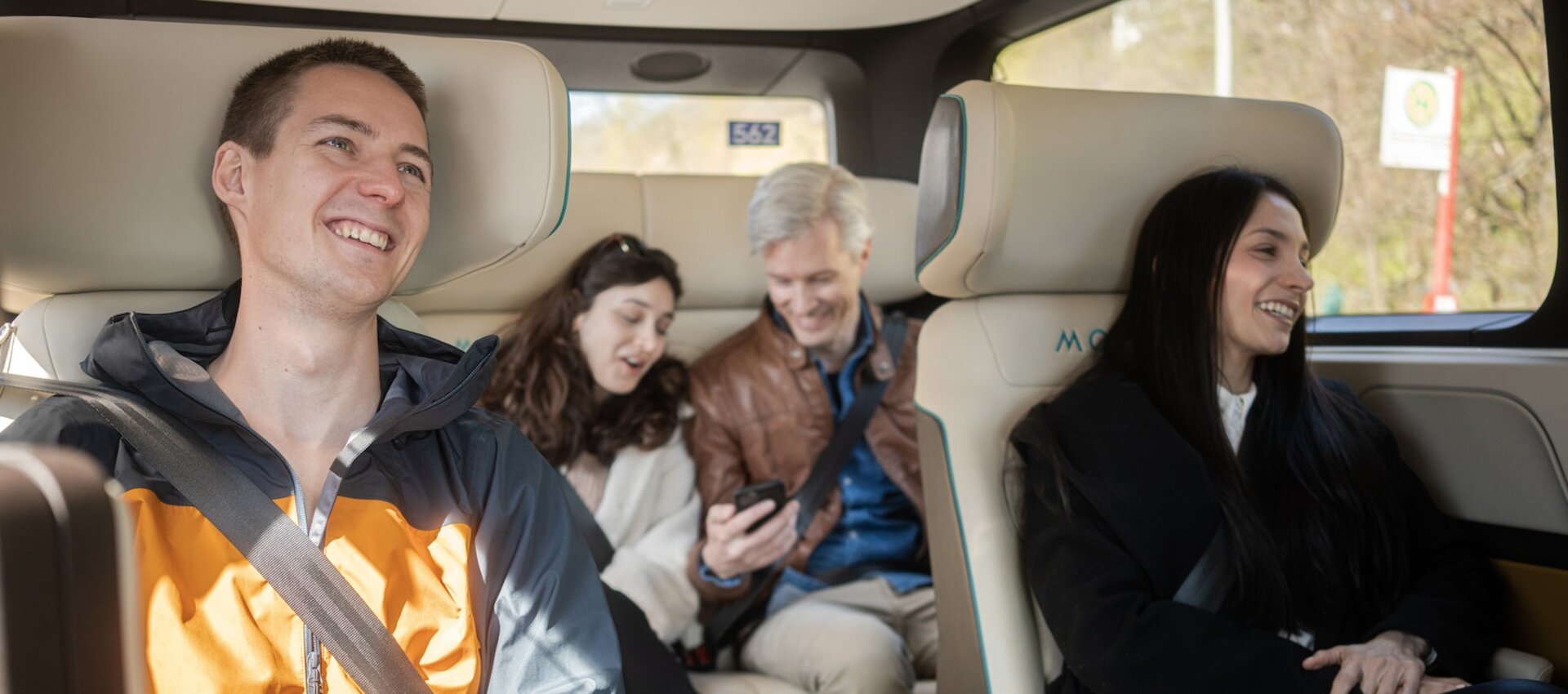Ridepooling-Definition and the situation in Germany
With ridepooling several requests from passengers who want to travel in a similar direction are bundled – journeys can be booked digitally and also paid for directly. The on-demand concept can best be compared to the well-known idea of the shared taxi. One key feature, however, is that with ridepooling a computer algorithm is used. It processes journey requests in the shortest possible time and combines several of them into a rational, efficient route.
Example: Kim wants to go to the city centre, while Luca would like to go to the tax office. Both are starting from the east of the city, so they have to travel in the same direction. Since the tax office is only a small detour from the direct route to the city centre, ridepooling combines Kim's and Luca's journeys. They share the route and the fare at the same time. The combined journey reduces the price for both.
Ridepooling in local transport ensures that passengers can share a vehicle as required. This also results in less traffic on the roads than if Kim and Luca were to drive their own car or - as with conventional taxis - each was carried by a separate vehicle.
Germany creates a legal framework for ridepooling
In August 2021, the reform of the Passenger Transport Act (PBefG) adopted by the then Federal Government came into force. As a result, Germany has created a legal basis for on-demand pooling transport and has taken on a pioneering role, setting an example for other countries.
Central to this are the new sections 44 and 50 of PBefG. These define what a "scheduled on-demand service" and "bundled on-demand service" are and under what conditions they may be operated. This legal certainty will enable on-demand concepts to help shape the mobility landscape in Germany in the long-term future. Through the law on autonomous driving (effective date: July 2021) and the downstream ordinance (effective date: July 2022), it will be possible to make ridepooling-services even more efficient and attractive in the future, making them an integral part of the urban mobility transition.
One example of a provider of ridepooling in Germany, is of course MOIA. Aside from Hamburg and Hannover, it is also worth taking a look at local public transport companies, who are additionally increasing their own ridepooling type offers.
How ridepooling differs from ridesharing
Essentially, ridepooling belongs to the category of so-called ridesharing services. However, not all ridesharing also qualifies as ridepooling. The biggest difference is the nature of the pooling, i.e. the intelligent bundling of journey requests. In addition, with ridepooling you are always taken to your destination by a professional driver. The term ridesharing includes, for example, typical carpooling that you organise privately - so the term not only includes commercial services.
What effect does ridepooling in local transport have?
- Complementing public transport. Ridepooling improves the accessibility of public transport, which at the same time makes it more attractive to more people. Established car users will also have a flexible and convenient alternative, allowing them to leave their car at home more often. Ridepooling also eliminates the stressful search for a parking space in the city and allows you to continue your journey directly by bus or train.
- Less traffic on the road. Ridepooling ensures that fewer people will find the need to use their car, which subsequently leads to more people being pooled in one vehicle. Overall, this would induce a reduction in the number of vehicles on the streets, especially in the case of large fleets.
- Positive effects on the climate. Reduced traffic also means reduced emissions. In addition, many ridepooling providers rely on e-vehicles, which can be operated emission-free. MOIA's vehicles, for example, are fully electric and run exclusively on green electricity.
An independent scientific accompanying study, which has examined MOIA’s service since 2019, confirms these points. Models show that the importance of the service may increase even more in the future. A key technology is automation, which further increases efficiency and also makes the services much cheaper for the public.
Here you can find the results of the accompanying research (PDF download)
FAQ on the subject of ridepooling
What does ridepooling mean?
Ridepooling is a digital-based mobility service. It involves bundling travel requests from several people who want to travel in a similar direction. The route planning, the allocation of trip requests to vehicles and their distribution etc. is carried out by an algorithm.
Does ridepooling ease traffic congestion?
With public transport as the backbone of urban mobility and in combination with other mobility services, ridepooling is an important component in sustainably easing traffic congestion. Even on its own, the principle of shared journeys is a useful measure for easing congestion.
Does ridepooling complement the existing public transport system?
Yes, ridepooling generally improves the accessibility of public transport - it thus provides access to other means of transport or serves as a link in combined use of different services. In addition, a tour effect can be observed with ridepooling (see MOIA accompanying research). For example, the respective service is used on the way to the destination, while public transport is used on the way back (or vice versa).
Does ridepooling also work in rural areas?
So far ridepooling services exist mainly in urban areas. For the offers to function meaningfully, a high density of demand and supply is required. This is often a problem in rural areas, where the demand is lower. This leads to longer empty runs and a lower ratio of passenger to transport kilometres, which makes pooling less efficient.
Sources
Section 44 of the Passenger Transport Act (PBefG): https://www.gesetze-im-internet.de/pbefg/__44.html
Section 50 PBefG: https://www.gesetze-im-internet.de/pbefg/__50.html
Bundestag reforms the law on passenger transport: https://www.bundestag.de/dokumente/textarchiv/2021/kw09-de-personenbefoerderungsrecht-824864

